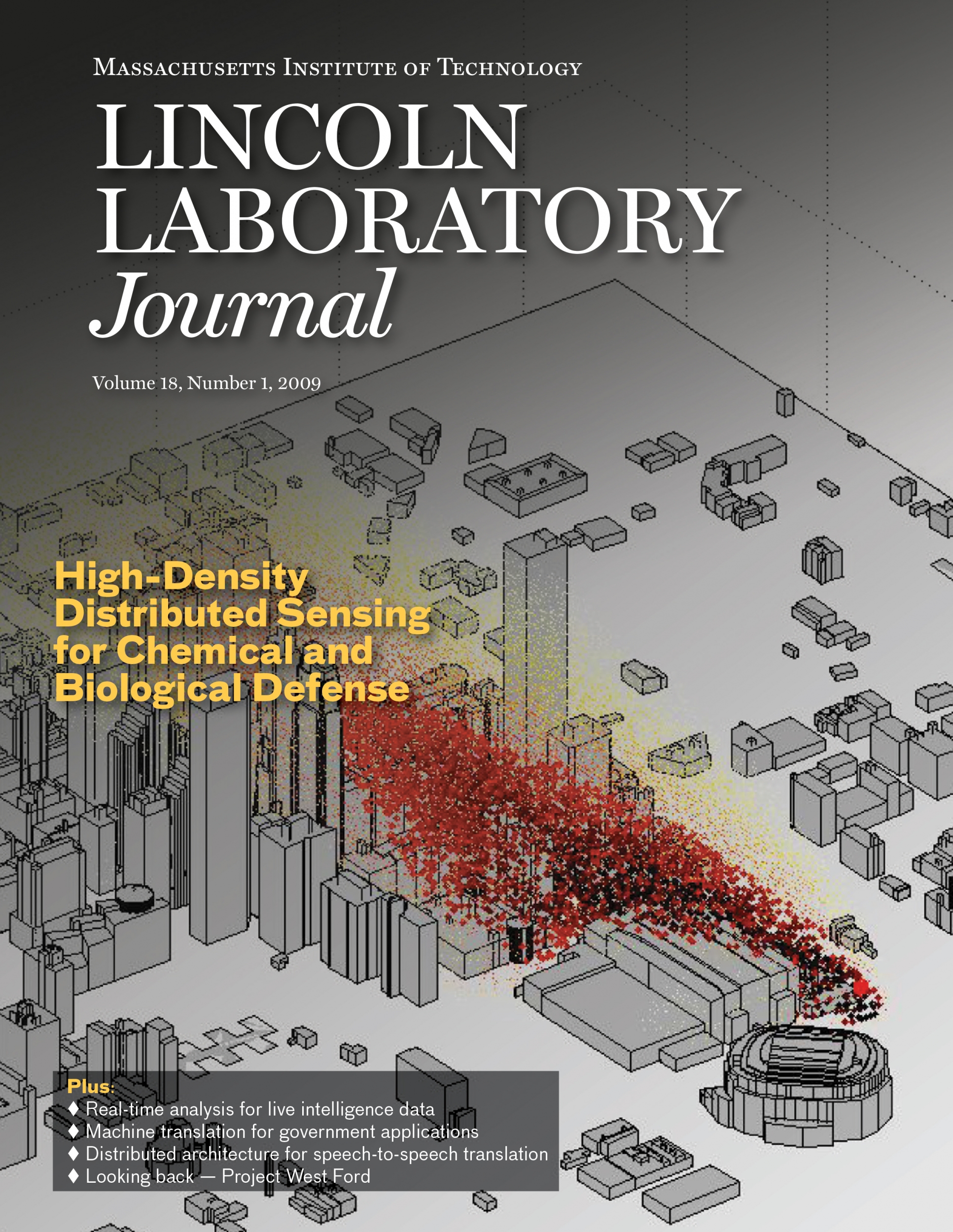Lincoln Laboratory Journal - Volume 18, Number 1

High-Density Distributed Sensing for Chemical and Biological Defense
By Adam Norige, Jason Thornton, Curran Schiefelbein, and Christina Rudzinski
A new sensing architecture is being developed for plume-based chemical and biological (CB) threat detection, mapping, and prediction. This effort seeks to provide a novel, affordable, and effective solution to spatially distributed CB detection by working in four key areas. These four areas include the analysis of performance gains offered by distributed sensing; the development of detection algorithms; the construction of an inexpensive sensor prototype; and experimentation with inexpensive, low-power deployment infrastructures. This multipronged approach to inexpensive spatially distributed sensing has led to the creation of a robust CB sensing architecture that offers many significant advantages over traditional approaches.
Machine Translation for Government Applications
By Douglas Jones, Wade Shen, and Martha Herzog
The idea of a mechanical process for converting one human language into another can be traced to a letter written by Rene Descartes in 1629, and after nearly 400 years, this vision has not been fully realized. Machine translation (MT) using digital computers has been a grand challenge for computer scientists, mathematicians, and linguists since the first international conference on MT was held at the Massachusetts Institute of Technology in 1952. Currently, Lincoln Laboratory is achieving success in a highly focused research program that specializes in developing speech translation technology for limited language resource domains and in adapting foreign-language proficiency standards for MT evaluation. Our specialized research program is situated within a general framework for multilingual speech and text processing for government applications.
Advocate: A Distributed Architecture for Speech-to-Speech Translation
By A. Ryan Aminzadeh and Wade Shen
Advocate is a set of communications application programming interfaces and service wrappers that serve as a framework for creating complex and scalable real-time software applications from component processing algorithms. Advocate can be used for a variety of distributed processing applications, but was initially designed to use existing speech processing and machine translation components in the rapid construction of large-scale speech-to-speech translation systems. Many such speech-to-speech translation applications require real-time processing, and Advocate provides this speed with low-latency communication between services.
Automated Indications and Warnings from Live Surveillance Data
By Paul J. Metzger
A software system called the Fusion Exploitation Tools (FET) underlies an automated process for alerting intelligence analysts when abnormal activity occurs in an area under their surveillance. The FET consists of algorithms that analyze vehicle and ship traffic. It works in conjunction with the Google Earth geospatial visualization system, presenting the user with a distributed network-centric way of visualizing this information. The FET is unique in that it automatically analyzes live intelligence data streams in near real time. The FET also incorporates direct machine-to-machine requests for additional data collection, providing both enhanced situation awareness and a timely and effective means to control sensor platforms.
Lab Notes
- Foul-Weather Friend › The Corridor Integrated Weather System now covers the continental United States, expanding air traffic planners' and airline dispatchers' view of the nation's weather.
- Going Beyond Limits › New lens lets microscopes peer at smaller objects.
- Early-Warning Chemical Sensors Pass an Indoor Test › A relatively cheap sensor system can detect indoor chemical weapons attacks.
- A Fast Switch › Work on a high-speed optical switch could provide one component for future communications networks.
- Dialect Detectives › Systems that distinguish among variants in spoken languages could enhance automated machine translation.
- Radio Wave of the Future › Modeling of communications protocols helps the military design next-generation software-defined radios.
- Plotting the Laboratory's Technology Future › Q&A with former chief technology officer Zach Lemnios on the Laboratory's strengths and challenges.
Looking Back
- Space Needles › Project West Ford proved that reliable, survivable communications were possible.